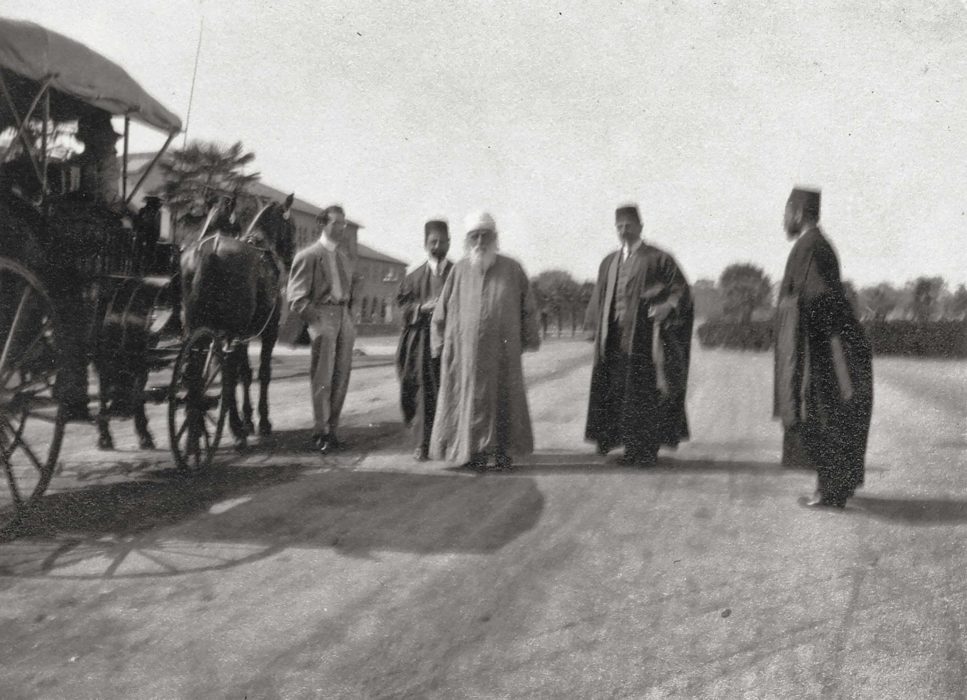DR. DAVID STARR JORDAN, the President of Stanford University, arrived at the train station in Palo Alto, California, to meet ‘Abdu’l-Bahá not long after 9 a.m. on Tuesday, October 8, 1912. Last Thursday, just a few hours after ‘Abdu’l-Bahá had arrived in San Francisco, Jordan had been one of the first to call on him. He invited ‘Abdu’l-Bahá to address his student body at 10:15 this morning.
Dr. Jordan, now sixty-two years old, had served as the university’s president since 1891 when the institution opened. Leland Stanford, Jr., an only child, had died of typhoid fever two months shy of his sixteenth birthday while on a trip to Europe in 1884. His parents — the tycoon, Senator, and former Governor Leland Stanford and his wife Jane Elizabeth Lathrop — founded the university in his memory. “The children of California shall be our children,” Leland Stanford said.
‘Abdu’l-Bahá left San Francisco early. He usually traveled with secretaries and a few other companions, but today an entourage of twenty-nine persons crowded into the train cabins for the commute south along the western shore of San Francisco Bay, through the lands that would later become known as Silicon Valley. From the Palo Alto station, ‘Abdu’l-Bahá rode in Jordan’s car up the long driveways to the Mission Revival buildings of Stanford’s Main Quad, which appeared on approach as a long low row of orange and red, stretched out above a lawn of green.

The large auditorium was filled to capacity with 1,800 students and 180 faculty and staff. Jordan mounted the stage with ‘Abdu’l-Bahá and began his words of introduction.
“It is our portion to have with us . . . one of the great religious teachers of the world, one of the natural successors of the old Hebrew prophets,” Jordan began. “He is said sometimes to be the founder of a new religion. . . . It is not exactly a new religion, however. The religion of brotherhood, or goodwill, of friendship between men and nations — that is as old as good thinking and good living may be. It may be said in some sense to be the oldest of religions.”
Then ‘Abdu’l-Bahá began. “Inasmuch as the fundamental principle of the teaching of Bahá’u’lláh is the oneness of the world of humanity,” he stated, “I will speak to you upon the intrinsic oneness of all phenomena.” It was a theme he had presented many times in America, but at Stanford, he would approach it from a scientific perspective.
“It is evident that each material organism is an aggregate expression of single and simple elements,” ‘Abdu’l-Bahá continued, “and a given cellular element or atom has its coursings or journeyings through various and myriad stages of life.” He summarized: “From the fellowship and commingling of the elemental atoms, life results.”
But ‘Abdu’l-Bahá’s argument wasn’t simply designed to explain the intrinsic oneness of material phenomena. The “myriad stages of life” — mineral, vegetable, animal, and so on — were progressive, culminating in the human being. ‘Abdu’l-Bahá’s purpose was to distinguish man from animal. “God has created man lofty and noble,” he said, “made him a dominant factor in creation.” While nature was about the “law of the survival of the fittest,” he said, humankind is designed to rise above it and demonstrate its intrinsic oneness. The alternative, he noted, is war. “It is my hope that you who are students in this university may never be called upon to fight for the dust of earth.”
After the meeting, ‘Abdu’l-Bahá went with Dr. Jordan on a tour of the campus; met thirty boys from the Montezuma School who had walked five miles from their school in Los Gatos and ridden thirty more on the train to meet him; stood giving an interview to a student reporter in the blazing sun on the wide, open driveway in front of the Quad; accompanied Jordan to Xasmin House, his home, for lunch and a rest; and then arrived in the president’s car at 4:30 p.m. for his next call of the day at the Waverley Street home of Mrs. Frederick Marriott, whose mother, Mrs. Isabel Merriman, had invited him for tea.

For the next three and a half hours ‘Abdu’l-Bahá conversed with visitors including Professor Gray of Stanford and Reverend Clarence Reed, at whose Unitarian Church ‘Abdu’l-Bahá was scheduled to speak at 8 p.m. Given the name of the church, ‘Abdu’l-Bahá again spoke on unity. In return for the glorious bounties of God, he said, “[w]e must all become unified as one family. We must all become as one people. . . . We must all become as one nation.”
Dinner was served back at the house by Mrs. Merriman at 9 p.m., and then ‘Abdu’l-Bahá talked with Mr. H. W. Simkins, the editor of The Palo Altan, the local newspaper, an interview that went late into the night. When Mrs. Merriman suggested to ‘Abdu’l-Bahá that he would miss his train for the return trip to San Francisco, he replied: “Then we will stay the night.”
Mrs. Merriman had to quickly figure out how to find twenty-nine people places to sleep. Tabletops turned into beds, mattresses appeared in bathtubs. Mrs. Merriman, herself, slept in a clothes closet. “Thus ended,” historian Robert Stockman writes, “what may have been the most extraordinary day in ‘Abdu’l-Bahá’s North American tour.”
In tomorrow’s feature, ‘Abdu’l-Bahá’s landmark speech at Stanford University.






